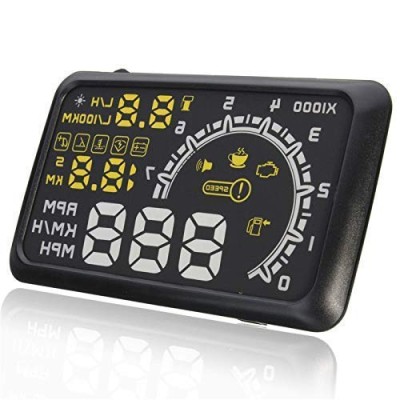HUD Head Up Display OBD II Projector
With the OBD II (Bus Automatic Diagnostic System) interface, you can automatically adapt to different car types. Look behind the steering wheel to see whether it has an automotive diagnostic socket.
Identify the car's 16-pin diagnostic socket and attach the OBD II cable to it if it has one.
Place the non-slip pad on the instrument window, then place the HUD on top of it. You may change the angle and location.
The reflective film may be stuck to the front windshield and attached to the front position of the HUD, guaranteeing that information such as vehicle speed can be projected onto the reflective film.
HUD's flexible alarm mode allows you to select between single-stage and four-stage overspeed warning modes, making driving more safer.
The driver may choose between three display modes: regular, high-speed, and automated.
- The Right Size
The display size is 5.5 inches, making it easy for the driver to see the information.
- Switches on and off automatically
To preserve the car's battery, begin with the vehicle beginning and end with the vehicle stopping.
- Adjustable Alarm Mode
HUD may select between single-stage and four-stage overspeed warning settings, making driving more safer.
- Alarm for Engine Speed
It helps to change gears in a timely manner to conserve gasoline.
- Brightness may be adjusted in a variety of ways.
To achieve the optimum condition that is in tune with the surroundings, the brightness may be changed automatically or manually.
HUD may automatically adjust to the car type based on OBDII or EUOBD (On-Board Diagnostic System).
Vehicle speed, Engine speed, water temperature, Voltage, Throttle valve position, Ignition advance angle, Time of 100 kilometres acceleration, Fuel consumption, Mileage, Low fuel tips, Engine failure are only some of the data that may be shown on the HUD at the same time.
1. OBD II (Bus Automatic Diagnostic System) interface automatically adapts to different car types. Look behind the steering wheel to see whether it has an automotive diagnostic socket.
2. Locate the car's 16-pin diagnostic socket and attach the OBD II cable to it if it has one.
3. Place the non-slip pad on the instrument panel, then place the HUD on the non-slip pad. Adjust the angle and position as needed.
4. The reflective film may be attached to the front position of the HUD and adhered to the front windshield, allowing information such as vehicle speed to be displayed onto the reflective film.
- Product Code:ASP_HEUP_D
- Availability:1
-
₹3,199
Tags: Universal HUD Head Up Display OBD II Projector Digital Light Speed Warning in India





